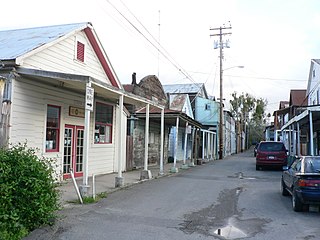
Locke, also known as Locke Historic District, is an unincorporated community in California's Sacramento–San Joaquin River Delta. The 10 acre town was built between 1893 and 1915 approximately one mile north of the town of Walnut Grove. Prior to the railroads and town, the delta swampland was home to Native American Miwok and Maidu tribes for hundreds of years. Tribal burial grounds exist on the Locke parcel. The village of Lockeport began where the Sacramento Valley Railway and Union Pacific Railroads merged at the southwest corner of the 490 acre swampland parcel deeded on July 6, 1883 to founder, George W. Locke, and his mercantile business partner, Samuel P. Lavenson. Both men were lured in their youth by the California Gold Rush from their birthplaces in New Hampshire.

The Perry County Jail, also known as the Perry County Jail Museum, is a history museum and historic jail in Pinckneyville, Illinois. Built in 1871, the jail was the second county jail used by Perry County. The county's first jail was built in 1833-34 and was demolished to make room for the new jail; it was a two-story brick building measuring 14 by 16 feet on the interior, and it cost $750 to build. The legislature passed two separate private laws to enable Perry County to obtain funds for the second jail's construction: one in 1865 to permit a tax levy, and the other in 1867 to permit the issuance of bonds. Although the county quickly solicited architects' plans upon being permitted to issue bonds, four years passed before they announced their choice of the design created by Cincinnati architect Samuel Hannaford. The contractor was chosen in May, a superintendent named in July, and the building deemed complete in December.

The Dubuque County Jail is a historic building at 36 East 8th Street in Dubuque, Iowa, United States. Completed in 1858, the jail is an example of the uncommon Egyptian Revival style. It is architecturally a highly original work of John F. Rague, who also designed the 1837 Old Capitol of Illinois and the 1840 Territorial Capitol of Iowa. The building was designated a National Historic Landmark for its architecture in 1987. It served as a jail for more than a century, became a museum in 1975, and was converted into county offices in 2016.

The Todd County Courthouse is the seat of government for Todd County in Long Prairie, Minnesota, United States. The hilltop courthouse was built in 1883 and is fronted by a street-level stone entryway and retaining wall constructed in 1938 by the Works Progress Administration. Additional modern buildings are set into the hill to the side and rear of the courthouse. To the southwest stood a residence for the sheriff with an attached jailhouse, built in 1900. They were extant in 1985 when the complex was listed on the National Register of Historic Places as the Todd County Courthouse, Sheriff's House, and Jail, but have been demolished since. The property was listed for having state-level significance in the themes of architecture and politics/government. It was nominated for being a good example of an Italianate public building and a long-serving home of the county government.
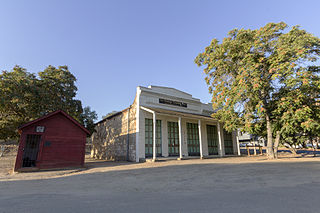
La Grange is a small unincorporated community in rural Stanislaus County, California. Its altitude is 249 feet (76 m). As of 2008 it has a population of 345. It is located at 37°39′49″N120°27′49″W along the Tuolumne River, and is near the La Grange Dam and the New Don Pedro Dam.

This is a list of the National Register of Historic Places listings in Tuolumne County, California.

The Tuolumne Meadows Ranger Station and Comfort Stations are examples of National Park Service Rustic design in Yosemite National Park. They are within the Tuolumne Meadows Historic District at Tuolumne Meadows. The ranger station was built in 1924 using peeled log construction. The ranger station doubled as the park entrance station for the Tioga Road. Its function was partly superseded by a newer structure in 1936, using larger quantities of stonework.

The Wiscasset Jail and Museum is a historic jail on at 133 Federal Street in Wiscasset, Maine. Built in 1811, it is one Maine's oldest surviving jail buildings, serving as the state's first penitentiary between 1820 and 1824. It is now a museum operate by the Lincoln County Historical Society as the 1811 Lincoln County Museum and Old Jail. It was listed on the National Register of Historic Places in 1970.

The Kettle Falls Historic District encompasses a remote pocket of early-20th-century industrial and commercial activity deep in the Boundary Waters, in what is now Voyageurs National Park in the U.S. state of Minnesota. Kettle Falls is the outlet from Namakan Lake into Rainy Lake on the Canada–United States border. The portage between the two lakes served as a key gathering point from the time of the voyageurs to the miners, commercial fishermen, and lumbermen at the turn of the 20th century, and tourists beginning in the 1930s. The Kettle Falls Dam was built at the site between 1910 and 1914, and two log buildings associated with its construction remain standing. The fourth contributing property to the historic district is the Kettle Falls Hotel, built in 1913.

The City Hotel in Sonora, California is a former hotel in downtown Sonora at 145 South Washington Street. The building, constructed circa 1852, is associated with Alonzo Green, Sonora's mayor in 1852 and 1853, and James Lane. It includes a sitting room, bar and restaurant with rooms upstairs. It is built of slate, adobe, and red brick, and is one of Sonora's oldest buildings. It belonged to Olivier Bemis in the 1860s. In the early 1900s, the hotel ran a daily horse-pulled-bus service to meet trains. It was listed on the National Register of Historic Places for Tuolumne County, California in 1983.
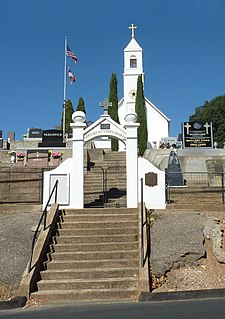
The Saint Sava Serbian Orthodox Church is a Serbian Orthodox church in Jackson, California. Built in 1894, the church was the first Serbian Orthodox church in America. Amador County had a large Serbian-American population in the late 1800s due to the California Gold Rush, and the county's Serbs established the St. Sava Church Organization of Amador County in 1886–87; the organization was responsible for purchasing land for and building the church, and the effort was led by Sevastijan Dabović. The church's original design had an Eastern Orthodox influence, complete with an onion dome; while the dome was later replaced by a bell tower, the church's stained glass windows and use of icons still give it a distinctive Eastern Orthodox character. The church has been used for Serbian-American religious and social activities since its opening and is now part of the Serbian Orthodox Eparchy of Western America.
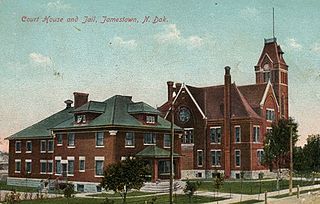
The Stutsman County Courthouse and Sheriff's Residence/Jail in Jamestown, North Dakota was built in 1883. It was listed on the National Register of Historic Places in 1976.
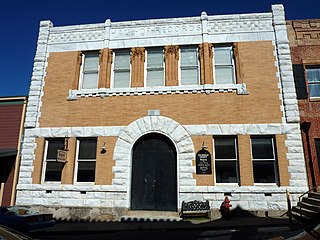
The Calaveras County Courthouse is a historic courthouse building in San Andreas, California. The brick courthouse was built in 1867 and contained the county's courtroom, jail, and sheriff's office; until 1888, executions were also conducted in the building. The county's Hall of Records was built in front of the courthouse in 1893; the two buildings nearly touch and are considered part of the same complex. The building's jail held outlaw Black Bart, a notorious Northern California highwayman, during his 1883 trial. In 1966, the county moved its courthouse to a new building; the old courthouse is now the Calaveras County Museum, which is operated by the Calaveras County Historical Society.

The Waushara County Courthouse, Waushara County Sheriff's Residence and Jail is a pair of buildings in Wautoma, Wisconsin that are together listed on the U.S. National Register of Historic Places.

Kewaunee County Sheriff's Residence and Jail is a building in Kewaunee, Wisconsin, located at 613 Dodge Street on the southeast corner of the courthouse square. It was built in 1876 as the sheriff's office, residence, and county jail. The building was added to the National Register of Historic Places in 1996.
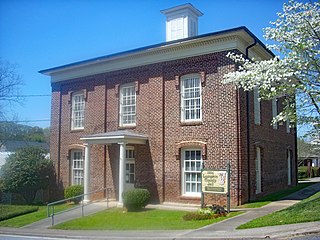
The Old Lumpkin County Jail is a historic jail building in Dahlonega, Georgia. The two-story brick jail was built in 1884. The first floor is now used by the Lumpkin County Historical Society and the second floor has been largely maintained in historic condition. Tours are given during Gold Rush Days in October. Bill Miner a.k.a. the Gentleman Bandit and Grey Fox were held in the jail. The county build a newer jail in 1964. It was added to the National Register of Historic Places on September 13, 1985. It is located on Clarksville Street.

The Superior Court of California, County of Tuolumne, also known as the Tuolumne County Superior Court, is the branch of the California superior court with jurisdiction over Tuolumne County.

Tidball Store or Jolon General Store is located off Jolon Road in Jolon, California, 1/4 mile south of the Dutton Hotel, Stagecoach Station. The store was constructed by pioneer, Thomas Theodore Tidball, from the remains of an old adobe inn built in 1868 by Flint & Bixby Stage Lines. Tidball supplied food, clothing, building supplies and other necessities to customers traveling through and to local ranchers and miners. The store was a major stagecoach stop on the old El Camino Real in the late 1880s. The landmark was listed on the National Register of Historic Places on December 12, 1976. It is the only standing commercial building of Jolon, once a major community of southern Monterey County.



















